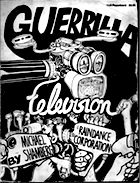Portapak world.
Wednesday, December 12th, 2007
 Sometimes I think I have Seasonal Nostalgic Disorder. I correlate it fairly closely with my attempts to clean our house…to remove the layers of clutter that come from the deadly combination of being alive for a good long time plus being fans of the printed word. The plus side of that is you come across stuff you think has long left for the dumpster. Like this book.
Sometimes I think I have Seasonal Nostalgic Disorder. I correlate it fairly closely with my attempts to clean our house…to remove the layers of clutter that come from the deadly combination of being alive for a good long time plus being fans of the printed word. The plus side of that is you come across stuff you think has long left for the dumpster. Like this book.
I have long been, as you know, a fan of television, and I remember getting very excited when Guerilla Television came out…this now thoroughly antique 1971 publication posited a world where television would be democratized by these newfangled “portapaks”—we’d all walk around with tiny video cameras, recording everything…and that would lead to A Better World.
Quoth Shamberg and company:
It may be that unless we redesign our television structure our own capacity to survive as a species may be diminished.
Wow. Far out, man!
The “first how-to book for new media tools” got me excited by the prospect of being able to create videos just like the big guys, but by the mid 1970s when I went off to college and actually tried to use a Portapak and looked at the results—blotchy, fuzzy black and white images that couldn’t even cleanly transition—in a cut—from one shot to another without additional hardware, more tape, a good deal of luck, and the willingness to put up with even more analog generation loss. That’s correct…you couldn’t cut…even that caused a roll and bounce of the wobbly helical videotape recording.
From my standpoint, this vision arrived well ahead of the technology, and in what may be a telling piece of self-realization, I knew that the only television I wanted to make was crisp, clean, and what was then called “broadcast quality.” I was willing to go work at “big media” (although it turned out to be a baby version of that at Ted Turner’s WTCG) to use (expensive) tools that made good-looking product…it didn’t bother me (again, tellingly) that my message was “watch Casablanca, tonight at 8 on the SuperStation.”
It took an extra decade or two for the vision of democratic television to become realized, but I think we are now living in a post-YouTube world, where it really is easy to put video “out there.” Yeah, maybe too easy.
But here, amidst a big-media writers’ strike, amidst consolidated big-media’s attempts to put out cheaper programming in as many monetizable (is that a word?) forms as possible, amidst endless uploads of water-skiing dogs, it a treat to be able to reread this early attempt to characterize what must have seemed like a far-off world…where everyone can do TV.
And the author? Well, he went on to become pretty big, old media—he produced The Big Chill, Pulp Fiction, and..uh..Reno 911. Wonder what he thinks about the strike? Or, about YouTube as the democratizing of television?

